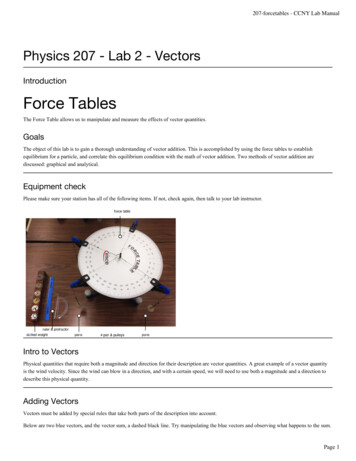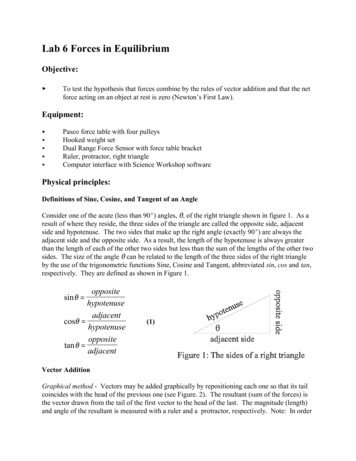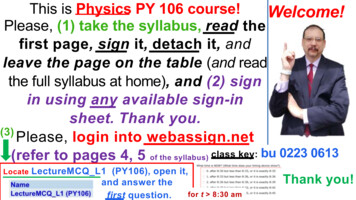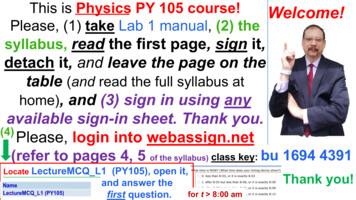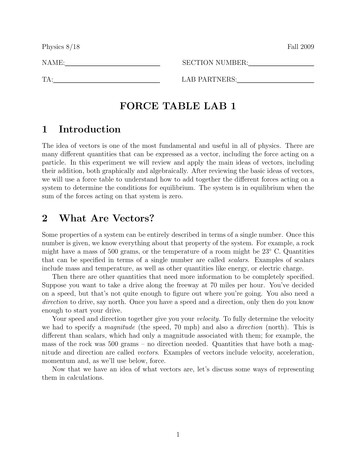
Transcription
FORCE TABLEINTRODUCTIONAll measurable quantities can be classified as either a scalar1 or a vector2 . A scalar has onlymagnitude while a vector has both magnitude and direction. Examples of scalar quantities are thenumber of students in a class, the mass of an object, or the speed of an object, to name a few.Velocity, force, and acceleration are examples of vector quantities. The statement “a car is travelingat 60 mph” tells us how fast the car is traveling but not the direction in which it is traveling. Inthis case, we know the speed of the car to be 60 mph. On the other hand, the statement “a cartraveling at 60 mph due east” gives us not only the speed of the car but also the direction. In thiscase the velocity of the car is 60 mph due east and this is a vector quantity.Unlike scalar quantities that are added arithmetically, addition of vector quantities involves bothmagnitude and direction. In this lab we will use a force table to determine the resultant of two ormore force vectors and learn to add vectors using graphical as well as analytical methods.DISCUSSION OF PRINCIPLESVector RepresentationAs mentioned above, a vector quantity has both magnitude and direction. A vector is usuallyrepresented by an arrow, where the direction of the arrow represents the direction of the vector,and the length of the arrow represents the magnitude of the vector. In three-dimensions, a vectordirected out of the page (or along the positive z -axis) is represented by (a circle with a dot insideit) and a vector directed into the page (or along the negative z -axis) is represented by (a circlewith an inside it). In mathematical equations a vector is represented as A . In some textbooks a vector is represented by a bold face letter A. The negative of a vector A is a vector of the same length but with a direction opposite to that of A . See Fig. 1 below.Figure 1: Vectors as arrows12http://en.wikipedia.org/wiki/Scalar (physics)http://en.wikipedia.org/wiki/Euclidean vectorc Advanced Instructional Systems, Inc and North Carolina State University1
The Cartesian coordinate system is used for graphical representation of vectors. The tail ofthe vector is placed on the origin and the direction of the vector is defined by an angle, θ (theta),between the positive x -axis and the vector, as shown in Fig. 2.Figure 2: Graphical representation of a vectorComponents of VectorsAn important technique when working with vectors mathematically is to break them down into their x and y components. In this example, we will consider the position vector A directed at anangle of 30 from the x -axis and having a magnitude of 8.0 miles. From the head of the vectordraw a line perpendicular to the x -axis and a second line perpendicular to the y-axis. We refer tothese lines as the projections of the vector on to the x - and y-axes. The projection of the vectoron to the y-axis gives the magnitude of the x -component of the vector (green line in Fig. 3 below)and the projection of the vector on the x -axis gives the magnitude of the y-component (red line inFig. 3).Figure 3: Breaking a vector into x and y componentsc Advanced Instructional Systems, Inc and North Carolina State University2
Note that the green and red lines in the diagram above form two sides of a rectangle with thevector as the diagonal of the rectangle. We can also look at the above situation in two other waysas shown in Fig. 4.Figure 4: Representing components of a vectorIn Fig. 4a we have a right triangle in which the vector is the hypotenuse, the side parallel tothe x -axis (green arrow) is the x -component of the vector, and the side parallel to the y-axis (redarrow) is the y-component of the vector. Figure 4b is mathematically equivalent to Fig. 4a, butnow Ay is drawn along the y-axis.Finding components given the magnitude and direction of the vectorWe know the direction of the Ax and Ay vectors, but to find their magnitudes we need to use some trigonometric identities. In Fig. 5 the hypotenuse represents the magnitude of the vector A and the other two sides of the right triangle represent the x and y components of the vector A .Figure 5: Finding the components of a vectorFor any right triangle, we have the following trigonometric identities.cos θ adjacent sidehypotenusec Advanced Instructional Systems, Inc and North Carolina State University(1)3
sin θ opposite sidehypotenuse(2)Here, adjacent side refers to the side that is adjacent to the angle θ and opposite side refers tothe side opposite to the angle θ. Let us consider the set-up in Fig. 5a. Using the definitions inEqs. (1) and (2), we havecos θ Axor Ax A cos θA(3)sin θ Ayor Ay A sin θA(4)In Fig. 5b however, the angle θ is defined differently. In this casesin θ Axor Ax A sin θA(5)cos θ Ayor Ay A cos θA(6)It is a common mistake to assume that Ax is always the cosine component and Ay is always the sinecomponent. However, this will depend on which of the two angles in the right triangle is defined asθ. Note that Ax is adjacent to the angle θ in Fig. 5a, while in Fig. 5b Ay is adjacent to the angleθ. In Fig. 3, the magnitude of A is 8.0 miles and its direction is 30 above the x -axis. So youfind the magnitude of Ax and Ay as follows:Ax A cos θ 8.0 miles * cos(30 deg) 6.9 miles(7)Ay A sin θ 8.0 miles * sin(30 deg) 4 miles(8)In other words, if you were walking, you could walk 6.9 miles due east (along the x -axis) then4 miles due north (along the y-axis). This would bring you to the same destination if you wereto walk 8 miles in the direction that is 30 from the x -axis.Finding the magnitude and direction of the vector from the componentsIf you do not know the magnitude or direction of the vector, but know the distances traveledin the x and y directions, you can use the Pythagorean theorem3 to find the hypotenuse, which isthe total distance traveled.3http://en.wikipedia.org/wiki/Pythagorean theoremc Advanced Instructional Systems, Inc and North Carolina State University4
A2 A2x A2y or A qA2x A2y(9)The direction of the vector can be found using one of the following equations. 1 θ sin 1AyA θ cos 1θ tan (10)AxA AyAx (11)(12)Some Basic Properties of VectorsTwo vectors are equal if they have the same magnitude and direction. So, on paper, you canslide a vector to a different location, but as long as you keep the same length and orientation for the arrow, the two vectors will be equal. In Fig. 6a the two vectors A and B have the same lengthand orientation.The negative of a vector has the same length but with the direction reversed, as shown in Fig.6b.A vector multiplied by a scalar will be a vector in the same direction as the original vector but with a different magnitude. In Fig. 6c p is a scalar. The vector B has the same direction as A but it is longer by a factor of p with p greater than 1. If p was less than 1, then B would be shorter than A .Figure 6: Vector propertiesGraphical Method of Adding Vectors Consider two vectors A and B oriented as shown in Fig 7. We would like to find the sum anddifference of the two vectors. Unlike adding scalar quantities, in this case we need to consider bothmagnitude and direction.c Advanced Instructional Systems, Inc and North Carolina State University5
Figure 7: Two vectorsTo add two vectors, slide the second vector so that its tail is at the head of the first vector. Thesum of the two vectors is a vector drawn from the tail of the first vector to the head of the second vector. In Fig. 8a, B is moved so that its tail is at the head of A . Note that the direction of B does not change. The red arrow gives the sum R A B . Addition is commutative, so you will get the same result by moving A to the head of B .To find the difference of two vectors, we can take the negative of the second vector and add it to the first vector following the steps described above for addition. In other words, A B A ( B ).This is illustrated in Fig. 8b.Figure 8: Sum and difference of two vectorsAnalytical Method of Adding VectorsAddition or subtraction of vectors involves breaking up the vectors into its components and thenperforming the addition or subtraction to the x and y components separately.Rx Ax Bxc Advanced Instructional Systems, Inc and North Carolina State University(13)6
Ry Ay By(14) Now using Eqs. (9) and (12) we can find the magnitude and direction of the resultant vector R .This process will be the same if you are adding more than two vectors or subtracting vectors.In Fig. 5a, Ax 1 and Bx 3 giving Ax Bx 4; Ay 3 and By 2 giving Ay By 1.These values agree with the x and y components of the red arrow in Fig. 5a.In the case of subtraction Ax Bx 2; Ay By 5. These values agree with the x and ycomponents of the red arrow in Fig. 5b.Force vectorsIn this lab you will deal with force vectors. In addition to the general properties of vectorsdiscussed thus far in this lab, the following definitions will be useful as you work through this lab.The vector sum of two or more forces is the resultant. The resultant can, in effect, replace theindividual vectors.The equilibrant of a set of forces is the force needed to keep the system in equilibrium. It isequal and opposite to the resultant of the set of forces.OBJECTIVEThe objective of this experiment is to find the equilibrant of one or more known forces using aforce table and compare the results to that obtained by analytical method.EQUIPMENTForce tableRulerStringsWeight hangersAssorted weightsBubble levelPROCEDUREGiven two force vectors you will determine the third force that will produce equilibrium in thesystem. This third force is known as the equilibrant and it will be equal and opposite to theresultant of the two known forces.You will use a force table as shown in Fig. 9, and work with force vectors. The force tablec Advanced Instructional Systems, Inc and North Carolina State University7
is a circular platform mounted on a tripod stand. The three legs of the tripod have adjustablescrews that can be used to level the circular platform. The circular platform has angle markings,in degrees, on its surface. Two or more pulleys can be clamped at any location along the edge ofthe platform. In this lab we will use three pulleys. Three strings are attached to a central ring andthen each string is passed over a pulley. Masses are added to the other end of the strings.Figure 9: Force tableThe hanging masses will produce a tension force in each string. The masses are directly proportional to the gravitational force (which you will learn about later in the course). The tensionforce in each string is equal to the gravitational force. For example, doubling the mass doublesthe force, etc. When the forces are balanced, the ring will be positioned at the exact center of thetable. When the forces are not balanced, the ring will rest against one side of the central post.Note: The force due to each hanging mass will be mg where g is the acceleration due to gravity.To make it easier to read the angles, assume the x -axis to be from the 180 mark to the 0 mark, with 0 being the positive x direction, and the y-axis to be from the 270 mark to the 90 mark with 90 being the positive y direction. See Fig. 10.c Advanced Instructional Systems, Inc and North Carolina State University8
Figure 10: Force table with axesProcedure A: Finding the Equilibrant of Two Known Forces1. Use the bubble level to check if the circular platform is horizontal. Use the leveling screws, ifnecessary, to make the necessary adjustments.2. You are given two 150 g masses that are to be placed at 60 and 300 .Remember that the weight hangers have a mass of 50 g each and this needs to be included as partof the hanging mass.You will determine the magnitude (in newtons) and angle of the third force needed to balance theforces due to these two masses.3. Represent these forces as vectors on the diagram in the worksheet. Be sure to include the axes.Each vector in the diagram should be drawn so that the larger the vector the bigger the force itrepresents.4. Calculate the x and y components (to the nearest thousandth of a newton) and enter thesevalues in Data Table 1 on the worksheet.5. Find the x and y components of the resultant of the two vectors and enter these values in DataTable 1 on the worksheet.6. Now calculate the x and y components of the equilibrant of these two vectors and enter thesevalues on the worksheet.7. Using Eqs. (9) and (12) calculate the magnitude and angle of the equilibrant. Enter these valueson the worksheet. These are the calculated value of the third force.8. Add this vector to your diagram to represent the third force.c Advanced Instructional Systems, Inc and North Carolina State University9
9. Position the third string at the angle you determined in step 6 and hang the mass (includingthe hanger mass) corresponding to the calculated third force to represent the third force.Make adjustments (if needed) to the mass and the angle until the ring is at the center. Record thisvalue on the worksheet.10. Compare the calculated and experimental values for the third force by computing the percentdifference between the two values. See Appendix B.11. Compare the calculated and experimental values of the angle for the third force by computingthe percent difference between the two angle values.CHECKPOINT 1: Ask your TA to check your diagram, calculations and the set-up on the force table.Procedure B: Determining the Placement of Two Unknown Forces12. Hang a 300 g mass (including the weight hanger) at the angle marking 150 .13. Choose values for the magnitude and angle of the second mass and enter this value in DataTable 2 on the worksheet.You should only use weights in 10 g increments. Values for F2 must be different from the ones usedin Procedure A.Think about symmetry when you choose the angle for F 2 .15. Draw the force diagram for this setup in the space provid
magnitude and direction. In this lab we will use a force table to determine the resultant of two or more force vectors and learn to add vectors using graphical as well as analytical methods. DISCUSSION OF PRINCIPLES Vector Representation As mentioned above, a vector quantity has both magnitude and direction. A vector is usually

